Madrid February 4-11 2019
It was another 100 km from the La Granja Palace to Madrid. The short route Google Maps took me on was up and over a mountain – there was lots of snow at the top of the pass at 1900m. The pine trees dusted with snow were very photogenic.
I stayed at a McDonald’s about 55kms from my appointment at the VW dealer and I foolishly waited until 8 to leave so hit rush hour. It took 1½ hours. Arrangements were made to have the back window replaced at 8 am.
I then had to wait to receive the mail sent from home. Supposed to arrive on the 7th, it didn’t, then there was a weekend and I ended up being in Madrid for 8 days.
MADRID (pop 3.2 million, metropolitan area 6.5 million)
The capital and the largest municipality of Spain and the third-largest city in the European Union(EU), smaller than only London and Berlin. The municipality covers 604.3 km2(233.3 sq mi).
Madrid lies on the River Manzanares in the centre of both the country. As the capital city of Spain, seat of government, and residence of the Spanish monarch, Madrid is also the political, economic and cultural centre of the country. In politics, education, entertainment, media, fashion, science culture and arts, all contribute to its status as one of the world’s major global cities.
Madrid is home to two world-famous football clubs, Real Madrid and Atlético de Madrid. Due to its economic output, high standard of living, and market size, Madrid is considered the leading economic hub of the Iberian Peninsula and of Southern Europe. It hosts the head offices of the vast majority of major Spanish companies, such as Telefonica, IAG, and Repsol. It is also the 10th most liveable city in the world according to Monocle magazine, in its 2017 index.
While Madrid possesses modern infrastructure, it has preserved the look and feel of many of its historic neighbourhoods and streets. Its landmarks include the Royal Palace of Madrid; the Royal Theatre with its restored 1850 Opera House; the Buen Retiro Park, founded in 1631; the 19th-century National Library building (founded in 1712) containing some of Spain’s historical archives; a large number of national museums, and the Golden Triangle of Art, located along the Paseo del Prado and comprising three art museums: Prado Museum, the Reina Sofía Museum, a museum of modern art, and the Thyssen-Bornemisza Museum. Cibeles Palace and Fountain have become one of the monument symbols of the city.
TIPS for Madrid
1. Transport pass
Tourist Travel Pass. Allows unlimited travel on public transport for 1,2, 3, 5 or 7 days and pre-loaded onto the Tarjeta Multi, a contactless, transferable smartcard that is valid for 10 years. Once the Tourist Travel Pass expires, you can top up the smart card with pay-per-ride tickets. Purchase the pass at all Metro stations, Cercanias Aeropuerto T4 station and tobacco shops.
2. Museum Passes Madrid
The following museum passes allow as many visits as you like for one year. Purchase at the first museum you visit. All have a reduced price if over 65, most often free, but this is supposedly only for EU citizens. All the sites in Madrid gave it to me but none of the sights outside the city. Need to show ID.
Paseo del Arte Pass. Allows visits without the need to queue for one year to the permanent collection of the three museums on the Paseo del Arte (Art Walk): the Prado, the Thyssen-Bornemisza and the Reina. 2018 price 29,60€ ( a 20% discount).
Annual State Museums Pass: Museum of Romanticism, National Museum of Anthropology, National Museum of Decorative Arts, Garment Museum, Cerralbo Museum, Museum of the Americas, National Archaeological Museum, Sorolla Museum, Prado Museum and the Reina Sofía Museum. 2018: 36,06€
Eight Madrid Museums: Valid for 15 days: Museum of Romanticism, National Museum of Anthropology, National Museum of Decorative Arts, Garment Museum, Cerralbo Museum, Museum of the Americas, National Archaeological Museum and the Sorolla Museum. 2018: 16€
Four Madrid Museums: Valid for ten days as many visits as you like: any of the museums above paragraph. €8
Five Museums. Another Madrid: Valid for ten days: Sorolla Museum, Cerralbo Museum, Lázaro Galdiano Museum, National Museum of Decorative Arts, and the Museum of Romanticism. 2018: 12€
If over 65, the museums are inexpensive and buying passes not recommended. Most museums are free or very inexpensive.
3. It is illegal to drive into Central Madrid. But I did all 4 days I was there and even found some dodgy parking. I am not sure what the fine is. There are lots of other vehicles, mostly taxis and service vehicles.
4. Parking. Half the population of the city must be parking police. They move up the streets taking photos of license plates that sync with the nearby parking pay machines. There is usually no ticket on your windshield; they are mailed from the authorities and you don’t know even if you have a ticket. The real problem is that the machines do not accept my Belgian license plates. Park outside and take the Metro in.
5. Metro. It is a difficult system to navigate (I give it a zero; Moscow in Cyrillic was easier). The issue is that there are no coloured lines to follow and all the stations are named from the terminal station. On the ride, most of the overhead notice is about the terminal line. And nobody speaks enough English to give good advice. The red line was half-closed necessitating 3 changes to get back to where I was going from Puerto Sol.
6. There are some things you cannot buy in Spain: chocolate milk, nacho cheese dip, breaded pork, or bacon lardons. They are also not available in France.
I have developed the following travel routine. I copy the Nomad Mania list for each destination and reorganize it by city. Using a large-scale Europe Road Atlas, I find everything using the index and Google Maps and highlight the sites on the map, often writing in shorthand the “sites” at each place. Then I follow the highlighted places as best as I can.
This has allowed me to stop buying travel guides that are at least 2 years out of date by the time you buy them, very expensive for the info and are not very critical. (I’ve spent thousands of dollars on Lonely Planets). I only used the attractions and city maps – most of the information in them is useless to me and usually not very realistic as everything is good. I can’t believe anyone would follow the restaurant guide (who knows who the owner is or who is cooking now). It is much more reliable to use Hostelworld for hostels and any of the hotel booking sites as the reviews are usually reliable – you would use them to book anyway. I never go shopping or out to nightclubs and am not interested in gay advice. Using mapping guides is easier than the maps – MapsMe is especially good and much more useful for multiple entries than Google Maps in cities as it keeps bookmarks to allow you to follow the best route.
I write my posts using the museum guides, my experience, Wikipedia and other web info – all much more accurate and realistic information. I end up spending at least 3 hours per day writing the posts and determining my itinerary.
At the VW dealership, it took me a few hours to determine all the Madrid “sites”. It was a Monday when most museums were closed so saw all the others on the outskirts of central Madrid.
Day 1
All these skyscrapers are in the Cuatro Torres Business Area north of the centre. It is only possible to walk through the lobbies of these lovely buildings and in Cepsa, that is not even allowed.
Torre Cepsa is a skyscraper with a height of 248.3 m (815 ft) and 45 floors, the second tallest of the four buildings here, surpassed by Torre de Cristal by less than a metre. It is the second-tallest building in Spain and the 5th tallest building in the European Union.
Designed by Lord Foster, it was first known as Torre Repsol and would have served as headquarters for Repsol YPF oil and gas company. During the construction of the tower, Repsol decided to change the location of its future headquarters and the financial institution Caja Madrid purchased the building for €815 million in August 2007. In 2016 it was bought by Amancio Ortega, Europe’s richest man and founder of global fashion group and Zara owner Inditex (ITX.MC), for 90 million euros through his property investment arm, Pontegadea Inmobiliaria, one of the biggest property companies in Spain. He purchased the tower from Abu Dhabi tycoon Khadem al-Qubaisi, whose fund had exercised a last-minute purchase option from Spanish lender Bankia (BKIA.MC), its previous owner
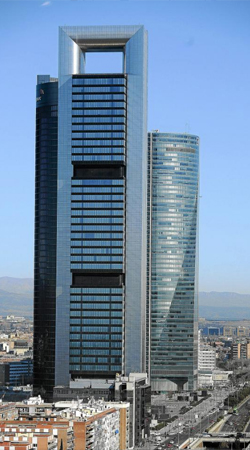
Torre PwC is a 52-floor, 236-metre-tall (774 ft) skyscraper, completed in 2008. It houses the five-star hotel Eurostars Madrid Tower, which occupies 60% of the tower, with rooms between floors 6 and 27 and at its upper part, a two-story dining room offering a panoramic view of the city. The professional services firm PricewaterhouseCoopers (PwC) moved its offices in the capital (about 2500 professionals) to this building in July 2011, taking up seventeen floors, between floors 34 and 50, which were vacant at that time. On the same date, the PwC logo was mounted at the top of the building, becoming the highest logo in Spain, installed at almost 236 meters of height. All the office floors have the same area of 1,258.23 m2 (13,543.5 sq. ft) and are divided into three sectors or segments. Floors 51-58 are intended for the general facilities and equipment of the tower.
It is the only tower with a double-skin facade and it is covered entirely of glass in the form of flakes. On the upper deck, there are 3 wind turbines, of 2.5 kW each, capable of producing wind energy for use in the building.
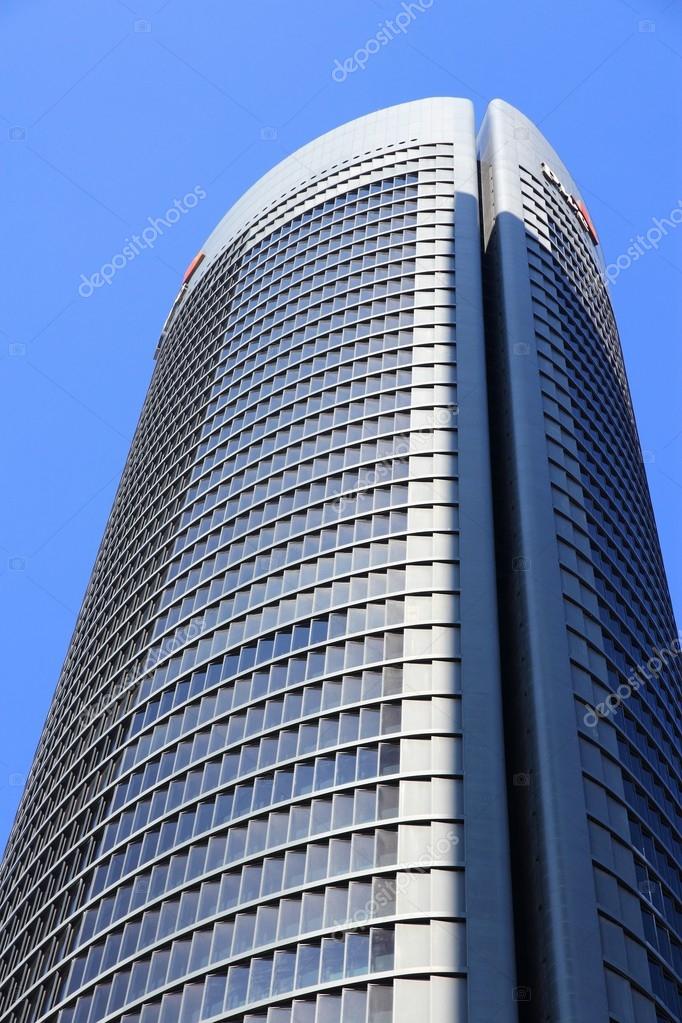
Torre de Cristal (Spanish for Glass Tower) was completed in 2008. With 50 floors, it has a final height of 249 metres, the tallest building in Spain and the fourth in the European Union surpassing neighbouring Torre Cepsa by only one metre.
It is the headquarters of KPMG.
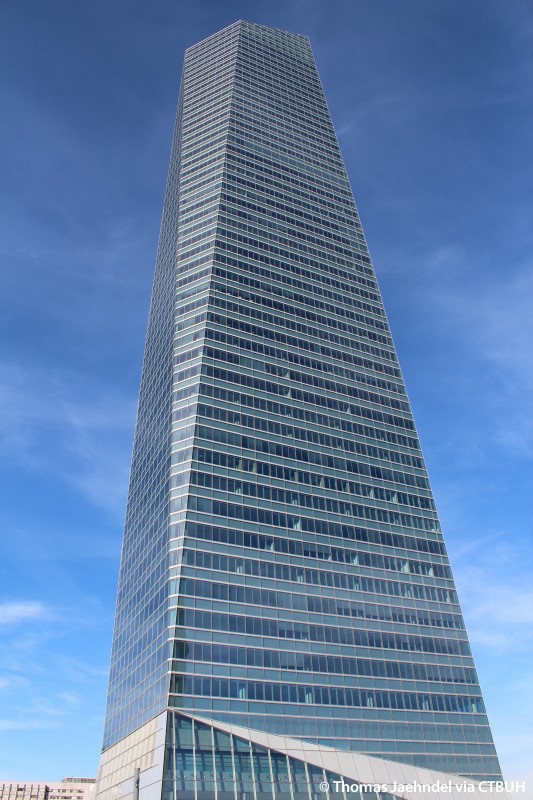
Torre Espacio (Spanish for Space Tower) is 230 metres (755 feet) tall and contains 57 floors. It is currently the fourth tallest building in Madrid. The building project was featured on the Discovery Channel’s Build It Bigger series due to the skyscraper’s unique form and shape. It was designed by American architect Henry N. Cobb, a partner in the firm Pei Cobb Freed. Since 2009 it has been the home of the British, Canadian, Australian, Netherlands and USA embassies in Madrid.

Zero Latency is a technology company that develops free-roam virtual reality systems. In August 2015, Zero Latency opened the world’s first VR entertainment venue in North Melbourne, Australia.
Following the success of Oculus Rift’s Kickstarter campaign, and was initially tested as a single-player game called Inversion VR, in early 2013. A prototype of Zero Latency’s multiplayer free-roam virtual reality system was first demonstrated to the public at Pausefest, a digital innovation conference, in early 2014. Following this with $30,000 from a crowdfunding campaign, a $60,000 grant from Film Victoria and $1 million from Carthona Capital, a venture capital firm.
In 2015, they partnered with Dell’s gaming division, Alienware, to provide high-performance computer hardware and developed the first public game played was a simulated zombie apocalypse with four players, however, the original game currently allows a maximum of eight players to play at once.
Free-roam virtual reality allows users to move freely in an open space and not be constrained by cables and other immobile equipment. Perceptual tricks such as “Change Blindness Redirection” are used in free-roam virtual reality to create the illusion of a virtual environment larger than what is physically available allowing a 400m2 venue in North Melbourne to allow players to travel between 700m and 1 km during a standard game session.
Motion capture technology is used to track the physical location of players, which allows the in-game virtual location of players’ avatars to be generated accurately. It took several years to develop the software and hardware allowing players’ physical movements to be instantly replicated by their in-game avatars. Proximity sensors are used to warn players of hazards and prevent players from leaving the physical play area. It also uses haptic feedback techniques (e.g. using fans to generate wind) to increase immersion.
Available to ticket holders aged 13 or older and also sells its systems to businesses requiring free-roam virtual reality applications as public virtual gaming spaces or theme park attractions. Zero Latency is open in 21 locations.
This was a difficult place to find – it is in a courtyard at 54 Calle de Pradillo. The small black front belies what is inside. Reservations need to be made (it is only open when there are sufficient people to play). The website was totally dysfunctional and I could not find out the price.
Zero Latency is in 21 other cities around the world.
Museum of Lázaro Galdiano houses the art collection of José Lázaro Galdiano in the palatial building constructed in 1903 as the residence of him and his wife. The library contains Galdiano’s important collection of incunabula and manuscripts. The conversion to a museum has respected the original interiors, which feature elaborate baroque-painted ceilings.
The collections are from the prehistoric period to the nineteenth century, with a focus on Iberian work. Major categories include jewelry, small bronzes, both ecclesiastical and domestic silver, ceramics, carved ivory, and numismatics. Objects come not only from Iberia but also from major centers of medieval artistry, including Limoges and Egypt. While the Renaissance is especially well represented, the collection features important early medieval objects, including Visigothic work, and works crafted by Iberia’s ancient Celtic culture.
The painting collection includes work by Bosch, Goya, John Constable, El Greco and many others. The garden is free to visit. €6
Convento de las Carmelites Descalzes. This is one of 22 convents owned by the Carmelite Descalzes Order, all in Spain or South America. This one is called Convento de San Hermenegildo. The order was founded in 1586 and this building was built in 1870. In an almost rural location west of the city, this convent is very austere, behind a large stone wall. The outside doors were open but were locked past the small entry. When I was there, a taxi with two nuns arrived. It is not possible to visit the convent.
Cathedral de Almundena. (Santa María la Real de La Almudena) is the seat of the Roman Catholic Archdiocese of Madrid. The cathedral was consecrated by Pope John Paul II in 1993.
When the capital of Spain was transferred from Toledo to Madrid in 1561, the seat of the Church in Spain remained in Toledo and the new capital had no cathedral. Plans to build a cathedral in Madrid dedicated to the Virgin of Almudena were discussed as early as the 16th century but even though Spain built more than 40 cities in the New World during that century and plenty of cathedrals, the cost of expanding and keeping the Empire came first and the construction of Madrid’s cathedral was postponed. All other main Spanish cities had centuries-old cathedrals, Madrid also has old churches but the construction of Almudena only began in 1879.
The cathedral seems to have been built on the site of a medieval mosque that was destroyed in 1083 when Alfonso VI reconquered Madrid.
The Neo-Gothic interior is uniquely modern, with chapels and statues of contemporary artists, in heterogeneous styles, from historical revivals to “pop-art” decor. The Neo-Romanesque crypt houses a 16th-century image of the Virgen de la Almuden, (Our Lady of the Hill), on a great silver base and surrounded by a great retabla. The ceilings are an architectural highlight.
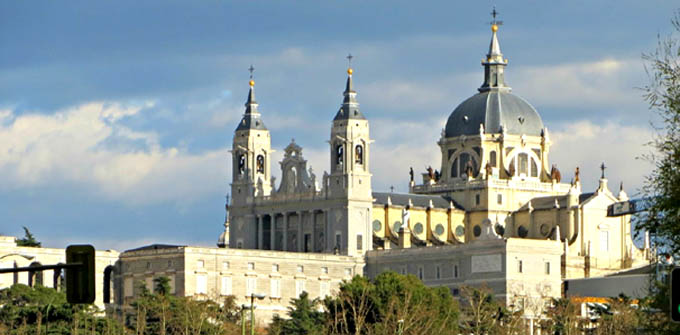
Royal Palace of Madrid (Spanish: Palacio Real de Madrid) is the official residence of the Spanish Royal Family in the city, but it is only used for state ceremonies. The palace has 135,000 square metres (1,450,000 sq. ft) of floor space and contains 3,418 rooms, the largest functioning Royal Palace and the largest by-floor area in Europe. King Felipe VI and the Royal Family do not reside in the palace, choosing instead the significantly more modest Palace of Zarzuela on the outskirts of Madrid.
Several rooms in the palace are regularly open to the public except during state functions. An admission fee of €10 is required. Some days it is free.
The palace is located on the site of a 9th-century Alcázar (“Muslim-era fortress”) and construction was from 738 to 1755.
The last monarch who lived continuously in the palace was King Alfonso XIII. The interior of the palace is notable for its wealth of art and the use of many types of fine materials in the construction and the decoration of its rooms. Also inside are the Royal Armoury of Madrid, porcelain, watches, furniture, silverware, and the world’s only complete Stradivarius string quintet. €11, 9 reduced.
It is highly recommended to buy tickets online to avoid the huge crowds at www.patrimonionacional.es

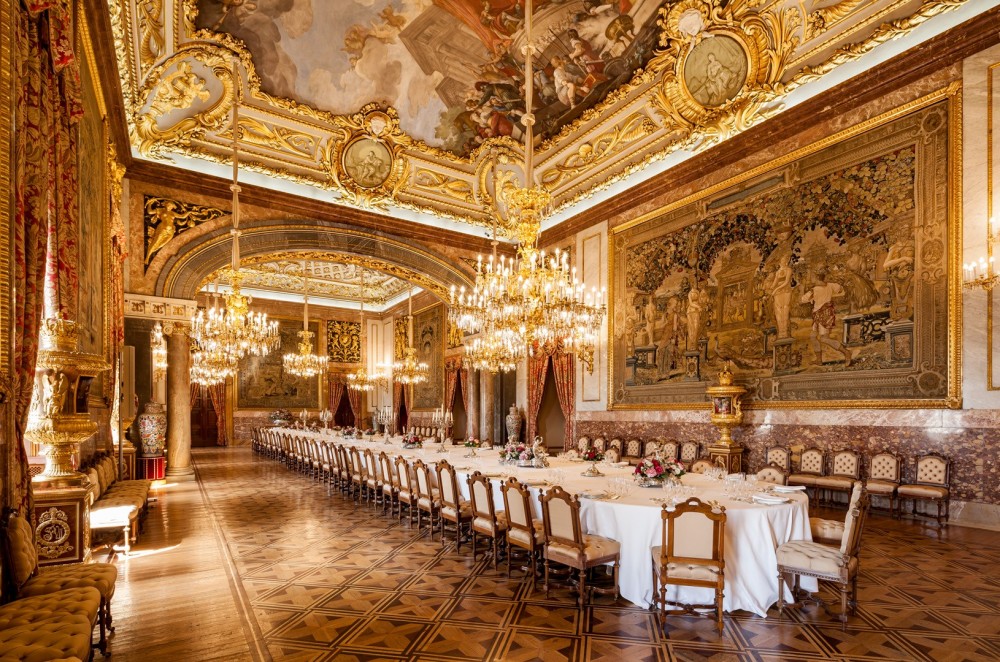
Market of San Miguel is a covered market originally built in 1916 with an iron girder structure supported by great posts. It was purchased by private investors in 2003 who renovated the iron structure and reopened it in 2009.
San Miguel Market is the most popular market in Madrid among tourists since it is located in the centre of Madrid, within walking distance from Plaza Mayor. The market is not a traditional grocery market but a gourmet tapas market, with over 30 different vendors selling a wide variety of freshly prepared tapas, hams, olives, baked goods and other foods. Beer, wine and champagne are also available.
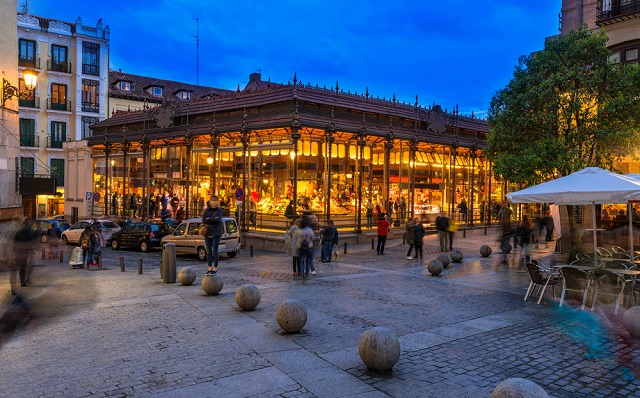

Restaurante Sobrino de Botin de Asar. The oldest restaurant in the world (verified by Guinness Book of World Records), it has run continuously since 1725. It has 3 floors, wood walls, a great miniature model and its original firewood oven. Its prices seemed rich: hor d’ouves €11-24, veg sides 12, eggs 11, and mains 24+. Hours are from 1-4 and 8-12 pm.

Plaza Mayor (Main Square) is a major public space in the heart of Madrid, once the centre of Old Madrid. It was first built (1580–1619) during the Habsburg period of Philip III’s reign. Only a few Spanish blocks away is another famous plaza, the Puerta del Sol. The Plaza Mayor is for the people of Madrid and tourists to shop, walk around, eat, and enjoy the outdoors.
History. The Plaza Mayor has suffered 3 major fires in its history. The first was in 1631, the second in 1670 and the last fire consumed a third of the square in 1790. Prior to this, the buildings that enclosed the square were five stories and this reconstruction lowered them to three stories, closed the corners and created large entrances into the squares. Today.Plaza Mayor is rectangular in shape 129 m x 94 m. 237 balconies are present on the three-story residential buildings that face inward towards the Plaza. To enter or exit The Plaza Mayor, there are ten entrances to choose from, however, there are nine gates. In the centre is the 1848 statue of Philip III on a horse, The Plaza Mayor has been the scene of multitudinous events. It has hosted executions in history. Today, it is the location of the annual Christmas market. It has also hosted bullfights and soccer games. Every Sunday and holiday it hosts stamp-collecting and coin-collecting markets in the mornings. It is near Botin.
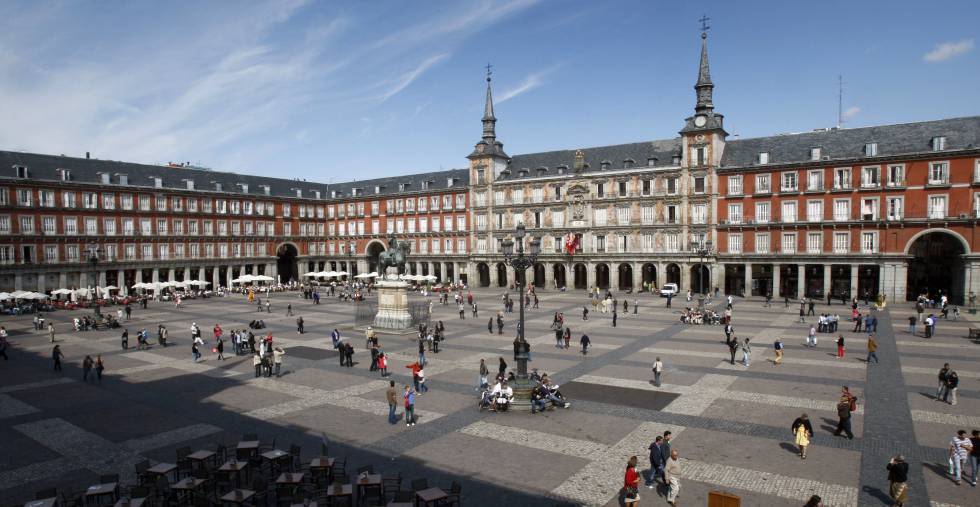
El Rastro is the most popular open-air flea market in Madrid held every Sunday and public holiday during the year from 9-3. It is located in the Rastro neighbourhood along Plaza de Cascorro and Ribera de Curtidores, between Calle Embajadores and the Ronda de Toledo (just south of La Latina metro station). A great variety of products (new and used) are sold and many antique shops in the local area are also open on Sundays.
After leaving my vehicle at the VW dealership at 8 am, I took the metro from Las Rosas station €3.15 (the last on the line) to the Retiro Station and walked through the huge park.
Day 2
Parque Retiro (“Park of the Pleasant Retreat”) is one of the largest parks in the city at 1.4 km2 (350 acres). The park belonged to the Spanish Monarchy until the late 19th century when it became a public park. At the edge of the city centre, it is a magnificent park, filled with beautiful sculptures and monuments, galleries, a peaceful lake, and a host to a variety of events, it is one of Madrid’s premier attractions. The Forest of Remembrance is a memorial monument to commemorate the 191 victims of the 11 March 2004 Madrid attacks.
Statue of Alphonso XII. Sitting on a lake across from the main north/south walkway through the park, it is imposing – the tall column with Alphonso on a horse is backed by a double-columned semicircle.
Palacio de Cristal. In the centre of Parque Retiro, this large glasshouse supported by steel girders is empty but you can see all there is to see through the glass doors at the back. It is part of the Reina Sofia Museum.
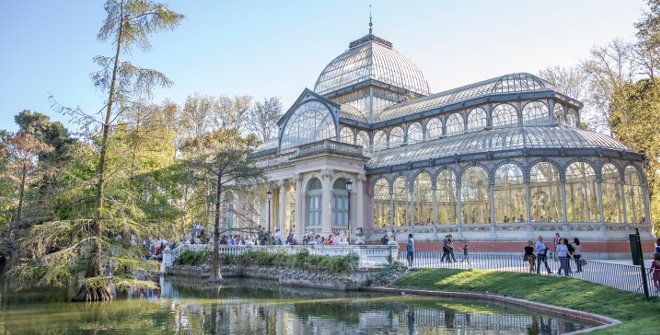
Madrid Atocha Station. The central train station is a lovely brick art deco building. A lush tropical forest fills the main part of the station. The tracks are below.
Reina Sofia. This modern art museum was closed on Tuesday. But this was the only museum I remember seeing when here in 2010.
Reina Sofia. The modern art museum of Spain is the only one of these museums I went to in 2010. It is closed on Tuesdays. Free if over 65, Monday-Saturday 7-9 pm and Sundays from 1:30-7.
CaixaForum. Sponsored by Caixa Bank, the one exhibit requiring a €5 ticket was a video on Spanish democracy only in Spanish. Spanish basketball and a photo exhibit on humanitarianism in the Mediterranean were both free. The stainless steel floor and stairs were attractive.
Royal Botanical Gardens. Established in 1781 by Carlos III, the gardens are on four levels. Being winter nothing was in bloom. €.50 reduced
Museo Nacional del Prado. The premier fine arts museum in Spain, it has pre-1800 art, much by Spanish masters like Valazquez, El Greco and Goya. This is one of those monstrous galleries (think of the Louvre, Hermitage or MOMA) that give museum fatigue. It reflects that there have been a lot of artists producing stuff for rich people through the ages. All the religious art helped create the myths around Jesus Christ (immaculate conception, gifts of the magi, original clothes of Mary and Jesus – all contrived to produce a good story). €15, €7.50 reduced
Monumento a los Caidos por Espana (Monument to the Fallen for Spain), popularly known as the ‘Obelisco’ (“Obelisk”) or the ‘Monumento a los Héroes del Dos de Mayo’ (“Monument to the Heroes of the Second of May”), is located in Plaza de la Lealtad, next to the Paseo del Prado.
It is built on the place where General Joachim Murat ordered the execution of numerous Spaniards after the Dos de Mayo Uprising of 1808. After various attempts to create a memorial as an homage to the participants of the uprising, the inauguration of the monument took place on May 2, 1840, the anniversary of the event. On November 22, 1985, King Juan Carlos I re-inaugurated the monument as a memorial to all those who gave their life for Spain, including those who died in conflicts other than the Peninsular War. Since then, a flame fuelled by gas has been constantly burning on the front of the monument. This parallels other war memorials around the world of national symbolic importance, frequently known as the Tomb of the Unknown Soldier.
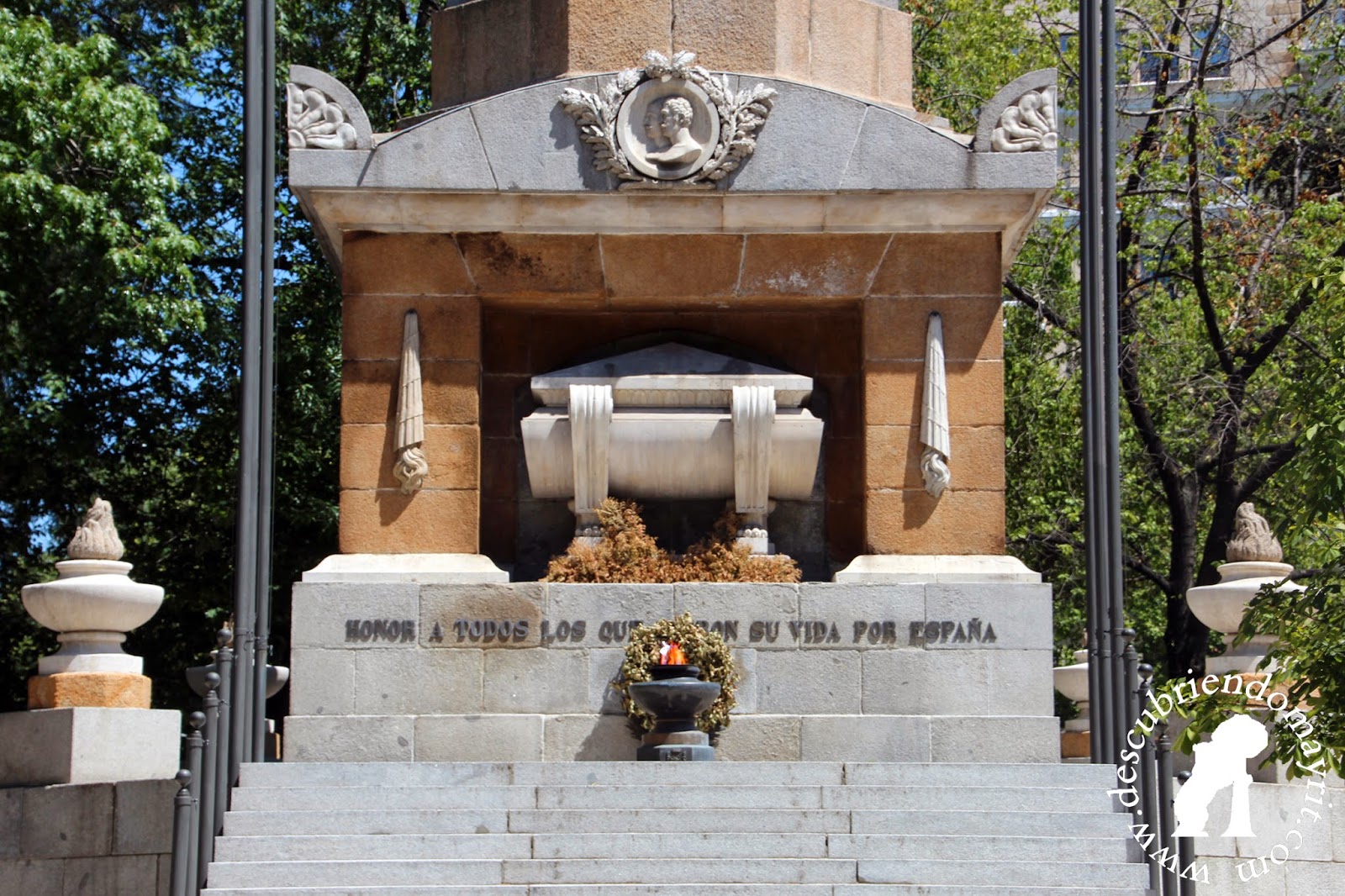
Thyssen-Bornemisza. This was my favourite of the three large art museums, a private collection acquired over two generations: Heinrich Thyssen-Bornemisza (1875-1947), his son Hans Heinrich (1921-2002) and his wife Carmen (who acquired an amazing collection even though she just started in 1987). The collection was acquired by the state and installed in the Palace of Villahermosa in 1992 and dates from the 13th century to the 1980s and includes a large collection of North American artists. of this man and wife, there were many of my favourite artists: Salvador Dali, Kandinsky, Magritte, Jackson Polluck, Van Gogh and others, and some of my least favourites: Piet Mondrian, Picasso and Braque. €12, €8 reduced
Arch of Carlos III sits in the middle of a roundabout.
National Archaeological Museum of Spain. These National museums usually hold the best treasures in the country. There were exhibits from several other countries, ones Spain had contributed fieldwork. There are some great Roman mosaics and religious ivory carvings. The most interesting exhibit in the money section was tevau or feather money, each using 300 male birds. Free of >65
Museo Naval de Madrid is a national museum showing the history of the Spanish Navy from the Catholic Monarchs, in the 15th century, up to the present. The displays set naval history in a wide context with information about Spanish rulers and the country’s former colonies. The collections include navigation instruments, weapons, maps and paintings. Some of the highlights are the map of Juan de la Cosa, the earliest preserved map of the Americas. €6, €3 reduced.
Palacio de Cibeles (formerly the Palace of Communication) until 2011, is a palace located on the Cybele Plaza. Named after Cybele, who gave the name to the plaza where it’s located, is currently the seat of the City Council, it opened in 1919 as the headquarters of Correos, the Spanish postal and telecommunications service. It hosts also a public cultural centre called Centro Centro. The central tower has a viewing point (mirador), a terrace from which visitors can view the city. Free
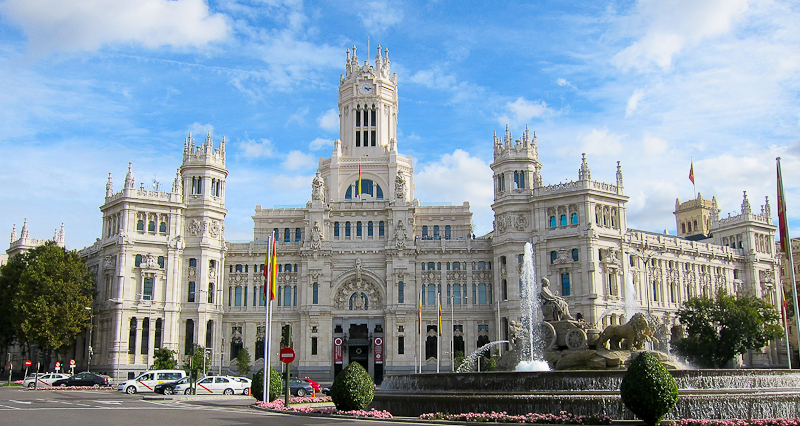
Decorative Arts Museum. This small museum takes up 3 floors in an old palace with mosaic floors. It is a quirky collection of clothes, furniture, poster art and many others.
Free if >65
Museum of Romanticism. Housed in an old palace, this museum highlights the various rooms and a lot of art, but also furniture and fans. €3
Puerta del Sol. This is the main square of the city marking one of the original gates in the city wall. The name comes from the rising sun that decorated the entry and is always mobbed by tourists. It is mile zero of the radial network of Spanish roads and contains the famous clock whose bells mark the beginning of the New Year.
Day 3
Two days in a row with sun and temperatures to +15! This was a big drive day to see two of the world heritage sites south and west of the city.
ARANJUEZ
Aranjuez is in a fertile valley where the Jarama and Tagus Rivers meet. Ferdinand and Isabella incorporated it into royal land and Philip II started to build a royal palace where the Spanish Hapsburgs spent a month in the springtime to enjoy nature. The 18th century Bourbons completed the palace and the Casa de Oficios. Philip V spent 3 months here and completed the town surrounding the palace at the end of the 19th century.
The huge St Anthony’s square fronts the Civil Servants House whose function was to manage the administration of the royal residence. There is a great fountain with lions, lizards and a sun star.
The Partaerre flower gardens have more fountains and a French-style garden. The Tagus River fronts the palace grounds and channels water around the palace to form the Renaissance Jardin de la Isla with more nice fountains, trees and gardens. An army of gardeners was raking leaves.
Inside there were the usual apartments with many paintings and period furniture, but two rooms were stunning. €9 (reduced fee not available to non-EU citizens). The Arabian Study is a small round room as exquisite as any Islamic room in the world (think the Nesrid Palace in Alhambra) with wonderful Maquina work in the ceiling and walls.
Even better (and I think one of the most remarkable rooms in the world) is the Porcelain Room whose walls and ceiling are covered in bas-relief Chinese scenes, vines and flowers and a big menagerie of animals. Most of the other rooms were over-the-top.
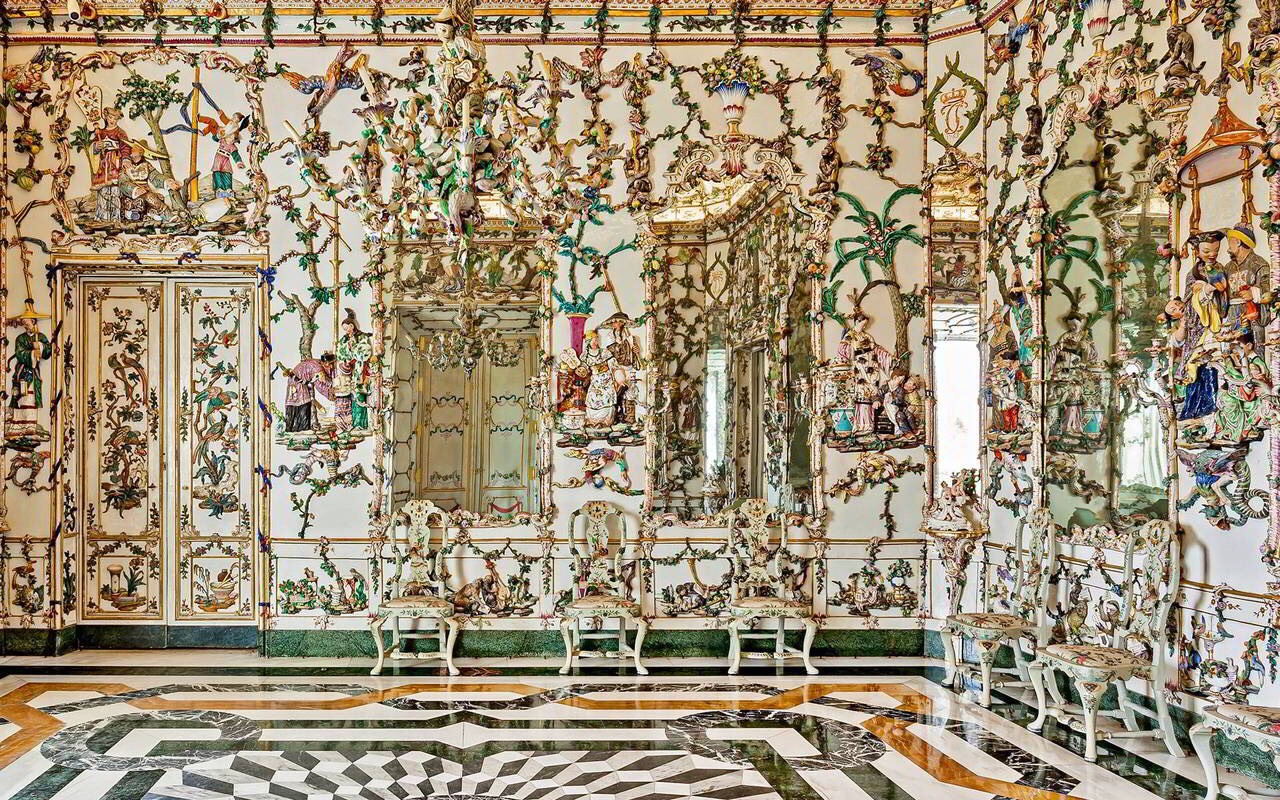
Sierra de Guadarrama National Park covers nearly 34,000 hectares, the fifth largest in Spain’s national parks system. It protects the eleven different ecosystems present in the Guadarrama mountains, including the only Iberian examples of a “high Mediterranean mountain”. There are more than 1,280 different species of which 13 are in danger of extinction, more than 1,500 native plants and 30 different types of vegetation. The species of animals in the mountains represent 45% of the total fauna of Spain – deer (red, roe and fallow), wild boar, wild goats, badgers, wild cats, foxes, hares, etc.; many species of waterfowl in the reservoirs, and great raptors like the Spanish imperial eagle or the Eurasian black vulture. Recently, a pack of wolves was discovered in the park after a 70-year absence in the region. and 18% of European fauna. The vegetation features Scots pine, oak and juniper.
Valle de los Caidos (“Valley of the Fallen”) is a Francoist regime monument, Catholic basilica and a monumental memorial in the municipality of San Lorenzo de El Escorial, erected at Cuelgamuros Valley in the Sierra de Guadarrama, about 70kms west of Madrid. Franco claimed that the monument was meant to be a “national act of atonement” and reconciliation.
The monument is considered a landmark of 20th-century Spanish architecture. The monument precinct covers over 3,360 acres (13.6 km2) of Mediterranean woodlands and granite boulders on the Sierra de Guadarrama hills, more than 3,000 feet (910 m) above sea level and includes a basilica, a Benedictine abbey, a guest house, the Valley, and the Juanelos — four cylindrical monoliths dating from the 16th century. The most prominent feature of the monument is the towering 150-meter-high (500 ft) cross erected over a granite outcrop 150 metres over the basilica esplanade and visible from over 20 miles (32 km) away.
Work started in 1940 and took over eighteen years to complete, with the monument being officially inaugurated on 1 April 1959. According to the official ledger, the cost of the construction totalled 1,159 million pesetas, funded through national lottery draws and donations. In 1999, the Valle de los Caídos was bombed by the Marxist terrorist organization GRAPO. €9
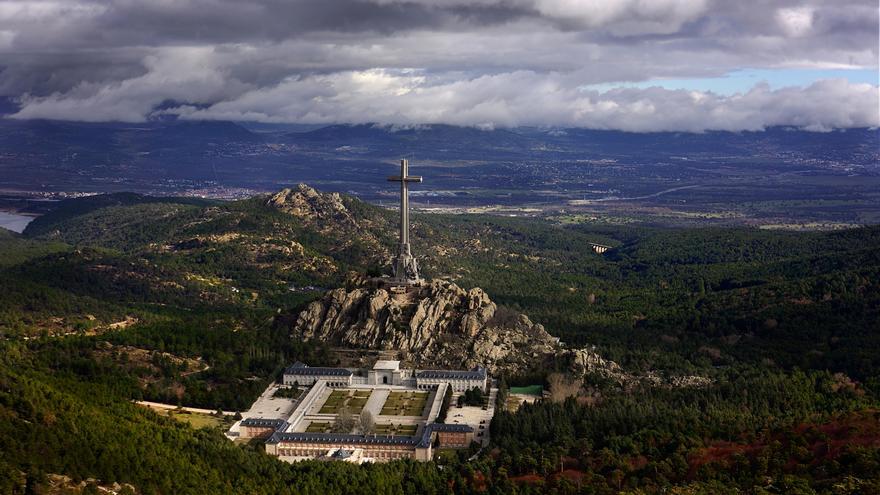
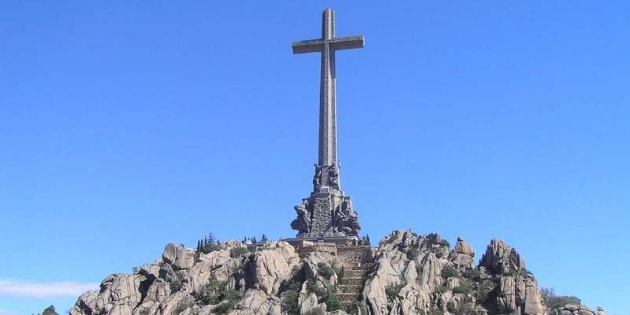
These sites have a dual nature; in the 16th and 17th centuries, they were places in which the power of the Spanish monarchy and the ecclesiastical predominance of the Roman Catholic religion in Spain found a common architectural manifestation.
Philip II of Spain, reacting to the changes of the 16th century, dedicated much of his lengthy reign (1556–1598) and much of his seemingly inexhaustible supply of New World gold to stem the tide. It was built from 1563-1584.
It is more of an art museum than anything – the lower cloister is surrounded by large frescoes, and the two chapter houses have many including El Greco”s “The Martyrdom of St Maurice and the Theban Legion”. In the basement pass through 9 tomb rooms, most with similar tombs of carved Carrera marble and holding most of the Bourbons and Hapsburgs. The first is the most interesting with exotic kings.
The most stunning is the Royal Pantheon entirely constructed of marble in an underground chapel where the many kings and their wives (if they bore sons who went on to be king) are buried.
The Hapburgs and Bourbon Palaces are next. €9
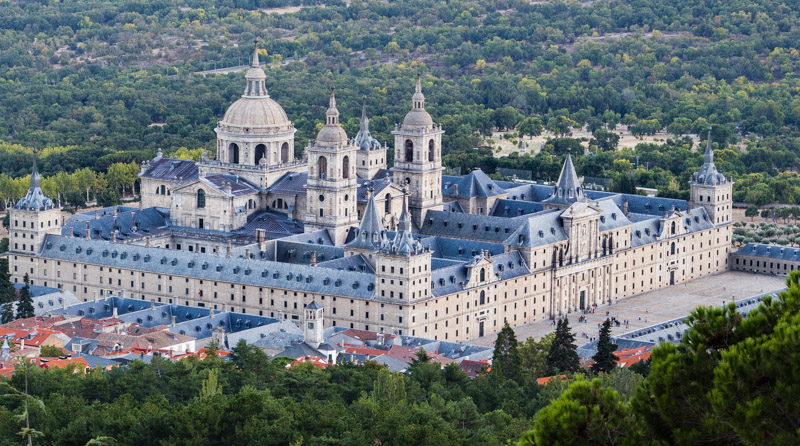
One of the most interesting art pieces was El Cabaria (The Crucifixion), by Roger van der Weyden (1399-1464), a Dutch artist and official painter of the city of Brussels in 1436. This is one of his most brilliant works, a stunning crucifixion painting. It is only one of three original works by him that are authenticated. It was originally a gift by the artist to a church in Brussels and was sold to Philip II for 100 livres in 1555 and arrived at Escorial in 1574. The restoration is well documented.
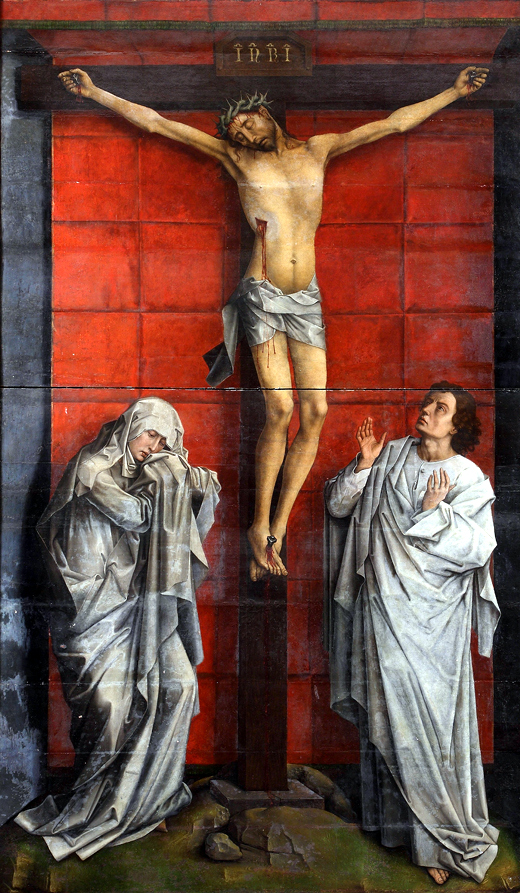
New Castle of Manzanares el Real (Castle of Los Mendoza), is a palace fortress erected in the 15th century in the town of Manzanares el Real at the foot of the Sierra de Guadarrama mountain range. Its construction began in 1475 on a Romanesque-Mudéjar hermitage and today is one of the best-preserved castles of the Community of Madrid. It was raised on the river Manzanares, as a residential palace of the House of Mendoza, in the vicinity of an ancient fortress that was abandoned once the new castle was built.
The castle now houses a museum of Spanish castles and hosts a collection of tapestries.
The castle looks very incongruous in its setting in a modern town and was a significant drive north of El Escurial on a lot of speed bump-controlled roads (ie not worth the drive). €5
My last day in Madrid was sunny and warm with a high of 18°C (my last day if my parcel comes – it has been in Spanish customs for 2 days), I tried to see a few things missing from my list. I started with a big walkabout that took over 4 hours as the distances on the map interfaces can be misleading. None of these were very close together. This was my first day wearing flip-flops in months.
Cineteca Matadero. Just on the SE corner of Plaza Legazpi, Matadero is a large visual art and cultural complex housed in an old, huge, pedestrianized brick/stone complex. This theatre shows documentary and art films from around the world. Go to www.mataderomadrid.org for movie lineups and times. The theatre is on the north end by the Matadero water tower.
Planetarium of Madrid. There were some great photographs of galaxies and nebula and in the basement a good display on climate change, an unusual thing in a planetarium. The €3.60 film was only in Spanish (as was the rest of the place). Otherwise Free.
To get here I crossed the tracks over a large inclined path that centred on a climbing wall so big it looked like a monument. I didn’t look used.
I then continued to what I thought was the National Museum of Natural Sciences, had a 3km walk out of my way, and finally gave up (MapsMe has not been of much help with this one).
Museo Ferrocarril de Madrid (Railway Museum). In the old Delicias train station (1880-1972), there are locomotives of all kinds (one steam locomotive had its “guts” exposed), model railways, some nice old passenger cars, construction and repair techniques, clocks and more but all is in Spanish. €4 reduced
I then had a drive about to see some places on the outskirts of Central Madrid.
Parquesur (South Park). This large shopping mall in south Madrid has it all – an IMax, cinema chain, all the usual chain stores, several department stores and playgrounds for kids. The nicest feature is the large fountain pool surrounded by restaurants. Only one story, it has a large footprint. There is lots of parking around, but often full.
My parcel did not arrive on Friday the 10th, nothing happened over the weekend and so I ended up spending the entire time at this mall, sleeping 3 nights and mooching free wifi for almost 3 days, getting caught up on all my posts and preparing for future travel.
El Corte Ingles (79 Calle Villaverde). This large department store chain has several outlets in Madrid, including two in Parquesur. The store at 79 Calle Villaverde is also part of a large mall. The stores have a complete selection of cosmetics and clothes for kids, women and men. The shoe department is mind-boggling in size.
Museo de Americas. In a lovely building in a park (and with a “space needle” very nearby, this museum has some nice pieces but is one of the worst curated museums I’ve been to in a while. There is no English and the labels were written by a technocrat, with little information on where the object came from. There were quite a lot of West Coast Canadian Indian pieces, collected when Spain was the first country to explore this part of the coast (go around Vancouver Island and see all the Spanish names). I knew many of the tribes but there was no info on where exactly the piece came from. The collection of gold from Quimbaya in Columbia was a highlight. Free if >65.
Museo de Traje. In a gorgeous new building set in a park, this museum is all about clothes, not ordinary clothes but those high-fashion clothes worn by aristocrats from the 16th century to the present. The modern stuff is over the top. Free if >65.
Sorolla Museum features work by the artist Joaquín Sorolla y Bastida (1863 – 1923), a Spanish painter. Sorolla excelled in the painting of portraits, landscapes, and monumental works of social and historical themes. His most typical works are characterized by a dexterous representation of the people and landscape under the bright sunlight of his native land and sunlit water.
The building was originally the artist’s house and was converted into a museum after the death of his widow. The principal rooms continue to be furnished as they were during the artist’s life, including Sorolla’s large, well-lit studio, where the walls are filled with his canvasses. Other rooms are used as galleries to display Sorolla’s paintings.
I loved everything here, most are painted with broad brush strokes and many pieces are portraits or have the ocean in them. The architecture is great with red marble door casings. The dining room may be the highlight as Sorolla covered the upper walls with vines, plants and fruit. Free if >65
PLAZA de CASTILLA. In the Nomad Mania “modern architecture/buildings series”, this is a large roundabout with the stunning 1996 Caja Madrid Obelisk donated by the bank Caja Madrid to the city. Initially, it was to be 120 meters tall but the complex network of underground tunnels that pass underneath the Plaza de Castilla made this unworkable and it was lowered to 92 metres. Not an obelisk itself, the 92m inner core is a 2m diameter cylindrical metal shaft that rests on three metal legs each weighing 50 tons on three 80-inch concrete piles 26 meters long.
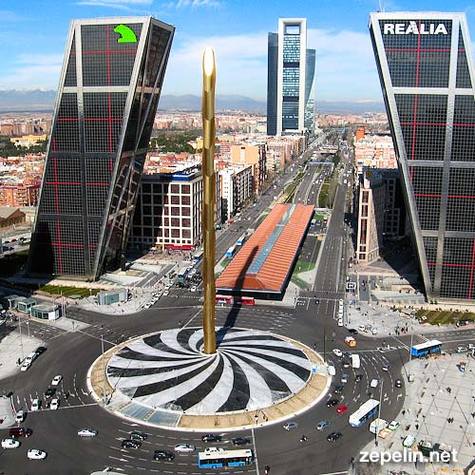
Gate of Europe towers (Puerta de Europa), also known as KIO Towers are twin office buildings here, each with a height of 114 m (374 ft) and have 26 floors. They were constructed from 1989 to 1996. Each building inclines at 15°, making them the first inclined skyscrapers in the world. After the receivership of Grupo Torras, KIO had to sell the buildings, which are now owned by Bankia and Realia.
The towers played a key role in the 1995 movie The Day of the Beast, the climax of which took place on one of the then nearly-completed towers.
The north-south road is tunnelled under the roundabout – to the south is a small, raised circular plaza with a nice statue “Espana a Calvo Sotelo” with pools and semicircular bas-relief carvings on both sides backed by a triangular monument.
On the east is a huge, modern water tower next to Parque Cuarto Depósito with a large square infinity pool. To the north on either side are two leaning skyscrapers owned by “Bankia” and “Reala”, both Spanish companies.

The Sorolla Museum and Castilla were a lovely way to finish a long hard day of walking and seeing several museums. I ate and slept on the street about 100m south of the roundabout.
Plaza de Toros de Las Ventas (often shortened to Las Ventas) is a famous bullring in the Guindalera quarter designed in Neo-Mudéjar (Moorish) style with ceramic heraldic crests of the different Spanish provinces. The price of the seats depends upon how close they are to the arena and whether they are in the sun or the shade. The bullfighting season starts in March and ends in October; bullfights are held every day during the San Isidro Fiesta, and every Sunday or holiday during the season. Bullfights start at 6 or 7pm and last for two to three hours.

The arena has a diameter of 60 meters, with the seats divided into 10 “tendidos” (groups of 27 rows around the arena), for a capacity of over 23,000. The Royal Box is of outstanding Mudéjar architecture, a complete bathroom and a lift.
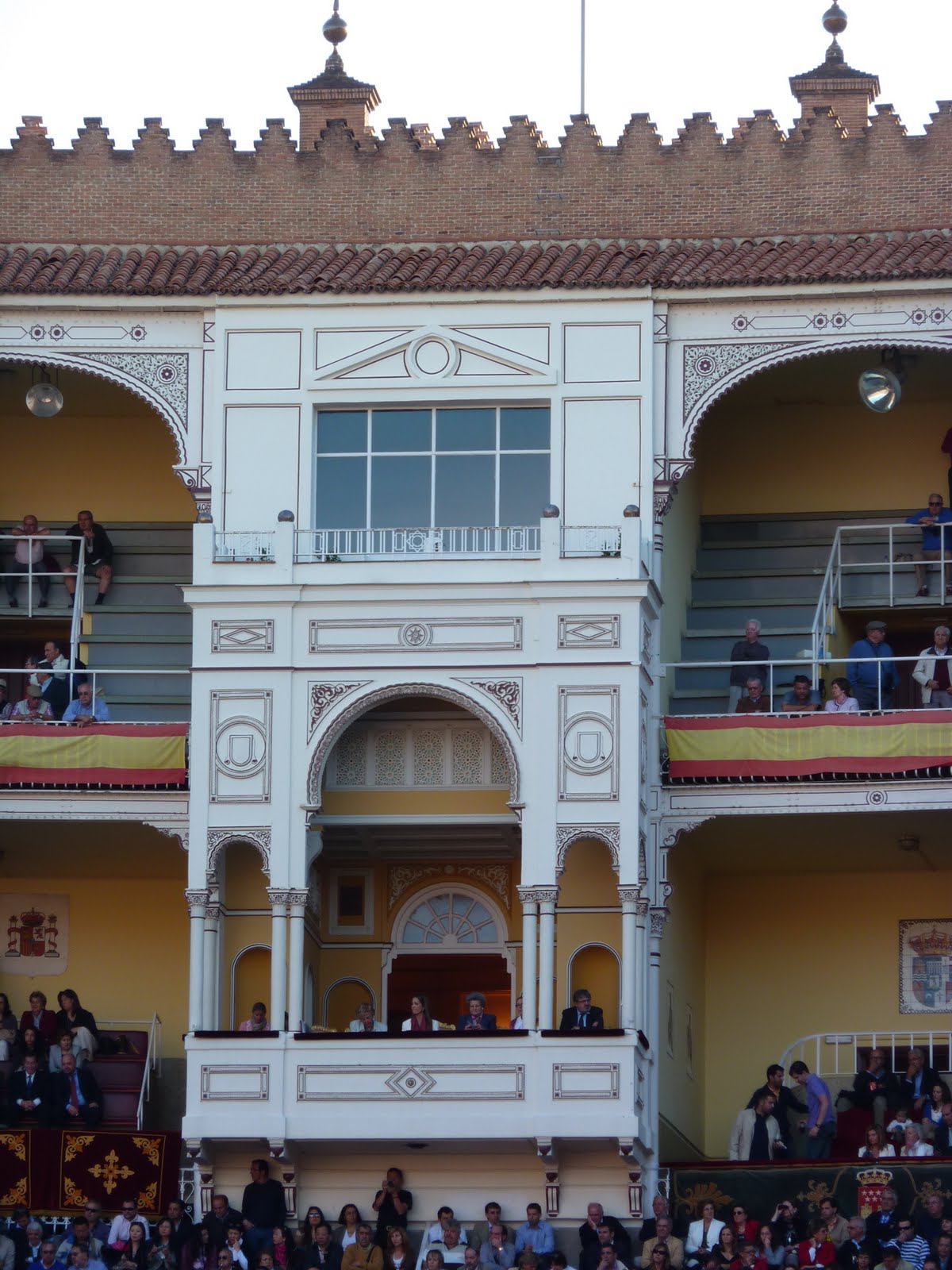
The bull ring has had many other uses. Concerts: the Beatles performed here in 1965, Diana Ross in 1991, AC/DC in 1996, Radiohead in 2003, Kylie Minogue in 2009 and Coldplay in 2011. Tennis: in 2008, the Spanish Davis Cup Team, led by Rafael Nadal, played their semifinal against the United States, and won it in front of their home crowd.
Theatre: since 2014, the venue has been set up like a theatre with 858 seats.
Day 5
This was a day off waiting to receive my mail: to do my laundry, catch up on some business and finally see my last museum. I haven’t missed much in Madrid.
National Museum of Natural Science. Another natural history museum with lots of stuffed animals, but here presented as a good exhibit on biodiversity. Photo Ark is an exhibit of photos (many taken in zoos but you wouldn’t know that) by Joel Sartare, a National Geographic photographer on a mission to take great photos, especially of endangered species. The biodiversity part was in English but the Photo Ark and exhibit on Iberian animals is not. €11.50 with Photo Ark, Free if >65
Day 6, 7 & 8
My parcel did not arrive on Friday the 10th, then it was the weekend, so I spent the entire time at Parquesur, the large shopping mall in south Madrid, sleeping 3 nights and mooching free wifi for almost 3 days, getting caught up on sleep, all my posts and preparing for future travel. At least I didn’t spend any money: nothing on gas or museums, my usual large expenses.
At 1 pm on Monday, I emailed the hostel and they had had my mail since the morning. After a 12km drive through busy Madrid, it was only a notice to pick it up and pay customs! But all was in Spanish, and the lady at the hostel was no help so I guessed to go to the post office at the airport, a 23km drive to the east. After a big walkabout, I finally found it and paid the €37 customs charge. At least it was in the direction I was heading. It will be lovely to have my Kindle after a month plus another credit card and debit card (you can’t have too many of these).
History. Romans conquered the area in the 1st century BC, and built the town of Complutum. After the downfall of the Roman Empire, under the Visigoths, it declined, although it also became a pilgrimage destination in remembrance of the Saints Justo and Pastor. The Moors arrived in 711 and subdued the Visigothic city and founded another site, building an al-qal’a, which means “citadel” in Arabic, on a nearby hill. Under Christian rule until the end of the Reconquista, the city had both a Jewish and a Moorish quarter and a renowned marketplace. Its central position allowed it to be a frequent residence of the Kings of Castile when travelling south. The city suffered severe damage during the Spanish Civil War.
The author Miguel de Cervantes was born here although his family moved when he was still young. The city celebrates his birthday, 9 October, every year and organizes an annual Cervantes festival. The local university is acknowledged as a global leader in the study of Cervantes and his works. Every year on 23 April, the anniversary of Cervantes’ death, the city of Alcalá hosts the ceremony awarding the Cervantes Prize, the Spanish-speaking world’s most prestigious award for lifetime achievement in literature.
University and Historic Precinct of Alcalá de Henares. The major landmark and one of the great prides of the city, its university, is spread throughout the city but generally exists in two campuses.
The Universidad Complutense, one of the oldest universities in the world, was founded by King Sancho IV of Castile as in 1293 in Alcalá de Henares. With the patronage of Cardinal Cisneros, it was recognized in a 1499 papal bull, and quickly gained international fame as the main center of learning of the Renaissance thanks to the production of the Complutensian Polyglot Bible in 1517, which is the basis for most of the current translations.
The university moved to Madrid in 1836 by royal decree. A new university was founded in the old buildings of the Universidad de Alcalá in 1977. Parts of the new university occupy the buildings of the old Universidad Complutense in the city centre, including the modern Colegio de San Ildefonso, and other Colegios, and the structures have served as a model for other universities across the Spanish territories in the Americas and other dependencies.
Cathedral. Aside from the buildings associated with the university, one of the city’s most important and historic buildings is the Cathedral-Magistral of Saints Justus and Pastor, known formally in Spanish as the “Santa e Insigne Catedral-Magistral de los Santos Justo y Pastor” or more familiarly as the “Catedral de los Santos Niños.” Constructed between 1497 and 1514, the Cathedral houses the remains of Saints Justus and Pastor, two Christian schoolboys martyred near the city during the persecutions of the Roman Emperor Diocletian at the beginning of the 4th century.
Today. The centre of the city remains essentially medieval, with many winding cobbled streets, and many historic buildings. The city centre surrounds Cervantes Square. The city includes the Moorish quarter, the Jewish quarter, and the Christian quarter. These distinct neighbourhoods have given Alcalá the reputation of “the city of three cultures.”
The old city centre has been largely preserved, unlike the suburbs. There has been no clear planning by the city councillors regarding expansion, and the sprawling suburban areas are irregularly constructed, with the addition of 1970s-style high-rise blocks in many places.
The city hosts a large population of international students due to the presence of the university and in particular its Spanish language and literature programs for foreign students. Alcalingua, a branch of the University of Alcalá, is one of the major foreign language learning centers for students from abroad.
The Storks. Acala is well known for its population of white storks. Their large nests can be observed atop many of the churches and historic buildings in the city, and are themselves a significant tourist attraction.
For over twenty years Alcalá’s storks have been counted and studied, and the active protection and maintenance of their nests is by official policy. Although once in danger of disappearing, with only eleven pairs counted between 1986 and 1987, the population has grown to around 90 resident pairs today, many of which have shortened the distance and duration of their typical migrations to remain in the city nearly all year.
University and Historic Precinct of Alcalá de Henares. The UNESCO World Heritage Site, I walked all over the historic district. The main square is lovely with flowers, French-style hedges and a double row of heavily pruned eucalyptus trees. The university buildings are spread all over the historic district, many in attractive brick/stone buildings from the 17th century and most convents at one time. It is possible to enter them all – all renovated inside to suit a modern university.
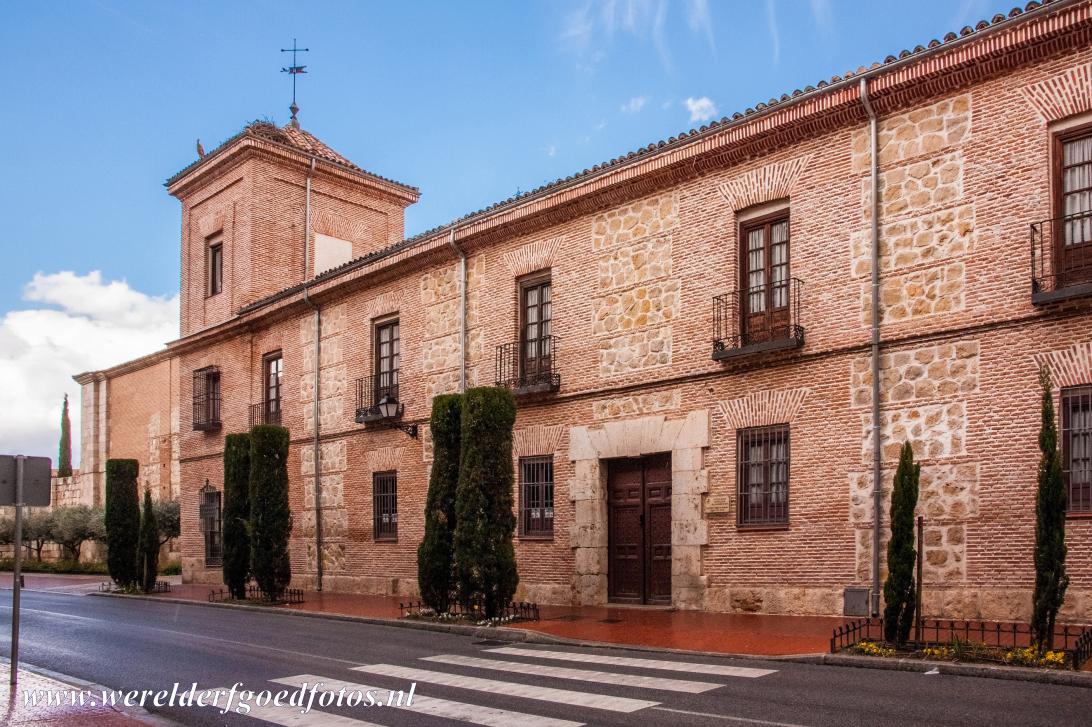
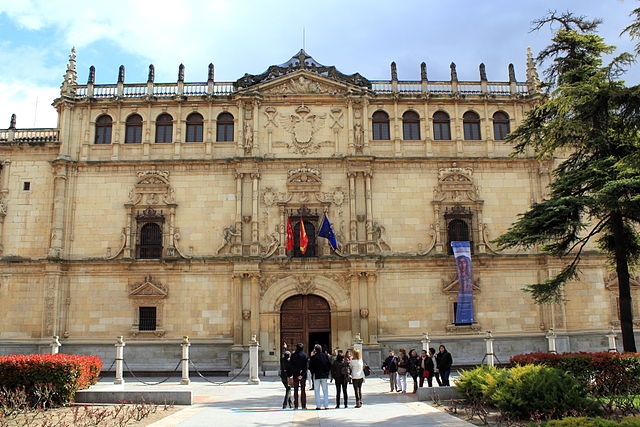
Palacete Laredo. Built in 1882, is a neo-Mudejar palace built by Manuel José Laredo and Ordoño as a private dwelling, between 1880 and 1884. It is of neo-Mudejar style, with interior decoration in plasterwork and tiles of oriental inspiration, like the minaret with the clock. In 1973 it was donated to the City and in 1988, they ceded it to the University of Alcalá.
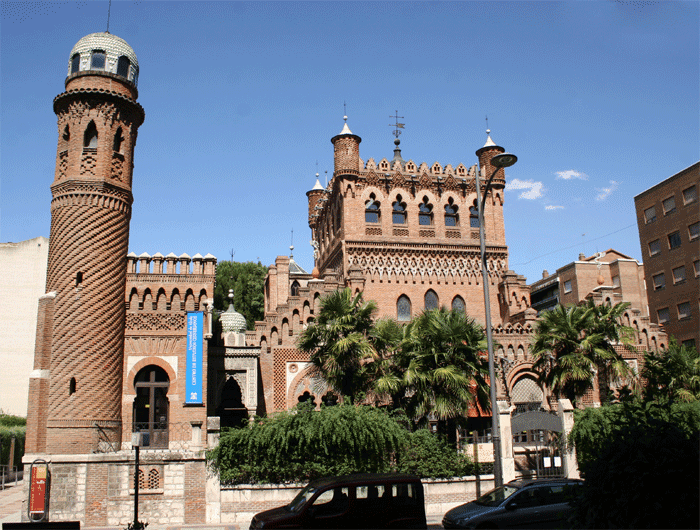
It is the headquarters of the Cisnerian Museum and the Cisnerian Research Center. It houses a collection of ancient documents from the University of Alcalá, including an original edition of the Polyglot Complutense Bible, and the Polyglot Bible of Antwerp. It is also the headquarters of the Institution of Complutense Studies
Its neomudéjar eclectic style incorporates Gothic, Renaissance, Pompeian and Modernist elements, with an exhaustive use of the decorative possibilities of the Caravista brick. Around the building is preserved one of the few romantic gardens that remain in the city.
In its interior, there are 15 original archaeological pieces moved by its owner from buildings of the XV and XVI centuries. Thus, the vault and columns of the Castle of Santorcaz, coffered ceilings of the Palace of the Marquises of Tendilla (Guadalajara), columns of the cloister of the Convent of Jesus del Monte in Loranca de Tajuña, tiles from the palace of Pedro I the Cruel of Jaén and Toledo. There are rooms inspired by the Alhambra and frescoes with Pompeian and Plateresque motifs. The Hall of the Kings is decorated with paintings of different monarchs, and on the roof presents a representation of the sky as it was conceived in the Middle Ages; currently serves as an assembly hall and conference room. The mixture of several architectural styles gives a uniqueness to the monument.
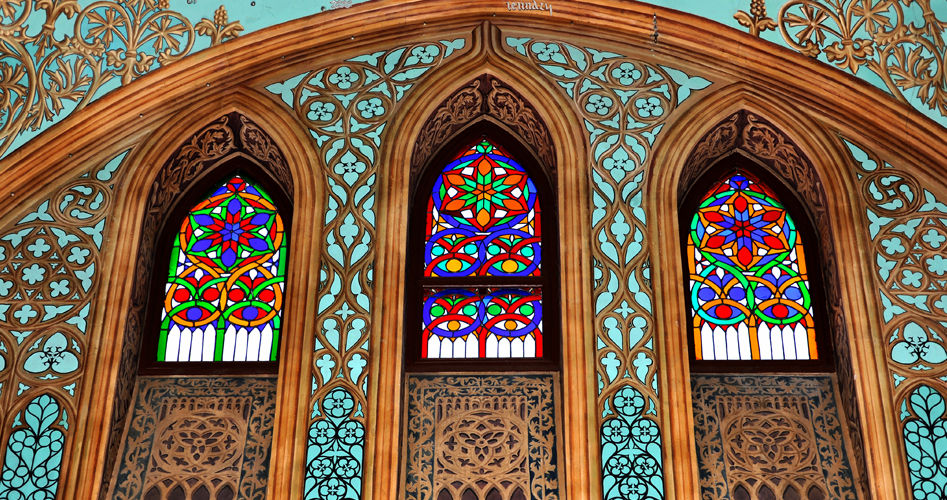
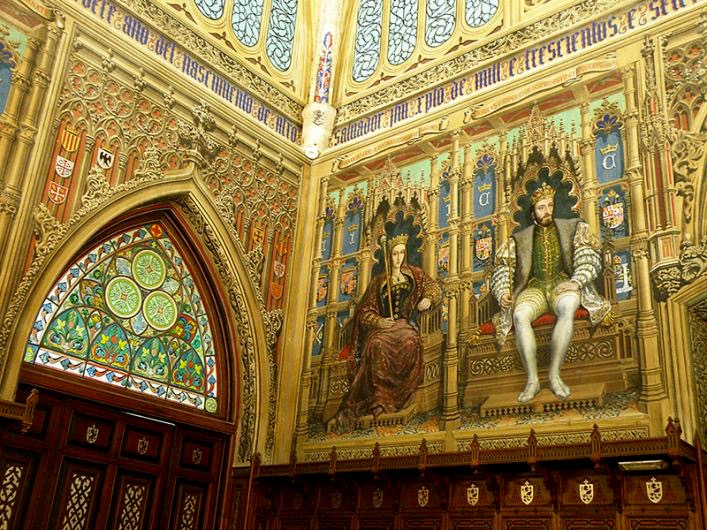


Regional Archaeology Museum of Madrid. Located in the former Madre de Dios Dominican Convent School, founded in the 17th century, its collection reveals the history of Madrid including the evolution of the landscape and fauna until the arrival of early man, the life of these settlers, the first producing societies, the Roman occupation, the Middle Ages and the transfer of the Spanish Court to Madrid from Valladolid. It also has a section devoted to archaeology as a science and its presence in the Community Madrid.
On the main square, the museum was being renovated and only the chapel with a few exhibits was available to see. Free
Museum of Outdoor Sculpture of Alcala de Henares is a permanent exhibition of contemporary art started by sculptor José Noja in 1993. The collection consists of 58 sculptures both figurative and abstract art, modern and contemporary works mainly Spanish artists, as well as Americans and Europeans. The sculptures are arranged in two urban sections: along the Complutense Avenue (Vía Complutense) and bordering the old city walls. This makes it the longest in its class of all Europe, with more than two kilometres long. There are interesting statues of important artists such as Amadeo Gabino, José Lamiel, Pablo Serrano or Úrculo, among others. Free